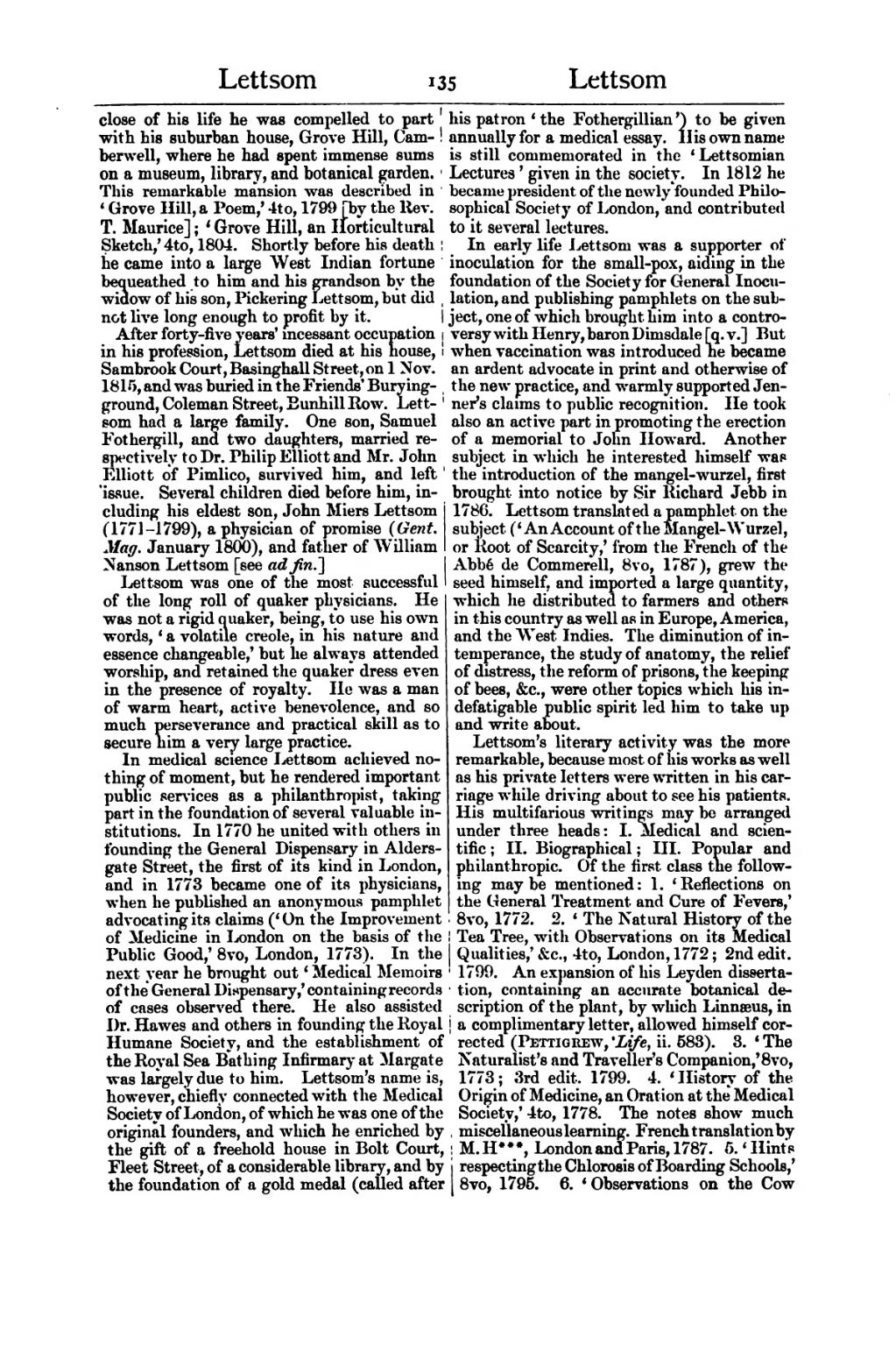close of his life he was compelled to part with his suburban house, Grove Hill, Camberwell, where he had spent immense sums on a museum, library, and botanical garden. This remarkable mansion was described in ‘Grove Hill, a Poem,’ 4to, 1799 [by the Rev. T. Maurice]; ‘Grove Hill, an Horticultural Sketch,’ 4to, 1804. Shortly before his death he came into a large West Indian fortune bequeathed to him and his grandson by the widow of his son, Pickering Lettsom, but did not live long enough to profit by it.
After forty-five years' incessant occupation in his profession, Lettsom died at his house, Sambrook Court, Basinghall Street, on 1 Nov. 1815, and was buried in the Friends' Burying-ground, Coleman Street, Bunhill Row. Lettsom had a large family. One son, Samuel Fothergill, and two daughters, married respectively to Dr. Philip Elliott and Mr. John Elliott of Pimlico, survived him, and left issue. Several children died before him, including his eldest son, John Miers Lettsom (1771–1799), a physician of promise (Gent. Mag. January 1800), and father of William Nanson Lettsom [see ad fin.]
Lettsom was one of the most successful of the long roll of quaker physicians. He was not a rigid quaker, being, to use his own words, ‘a volatile creole, in his nature and essence changeable,’ but he always attended worship, and retained the quaker dress even in the presence of royalty. He was a man of warm heart, active benevolence, and so much perseverance and practical skill as to secure him a very large practice.
In medical science Lettsom achieved nothing of moment, but he rendered important public services as a philanthropist, taking part in the foundation of several valuable institutions. In 1770 he united with others in founding the General Dispensary in Aldersgate Street, the first of its kind in London, and in 1773 became one of its physicians, when he published an anonymous pamphlet advocating its claims (‘On the Improvement of Medicine in London on the basis of the Public Good,’ 8vo, London, 1773). In the next year he brought out ‘Medical Memoirs of the General Dispensary,’ containing records of cases observed there. He also assisted Dr. Hawes and others in founding the Royal Humane Society, and the establishment of the Royal Sea Bathing Infirmary at Margate was largely due to him. Lettsom's name is, however, chiefly connected with the Medical Society of London, of which he was one of the original founders, and which he enriched by the gift of a freehold house in Bolt Court, Fleet Street, of a considerable library, and by the foundation of a gold medal (called after his patron ‘the Fothergillian’) to be given annually for a medical essay. His own name is still commemorated in the ‘Lettsomian Lectures’ given in the society. In 1812 he became president of the newly founded Philosophical Society of London, and contributed to it several lectures.
In early life Lettsom was a supporter of inoculation for the small-pox, aiding in the foundation of the Society for General Inoculation, and publishing pamphlets on the subject, one of which brought him into a controversy with Henry, baron Dimsdale [q. v.] But when vaccination was introduced he became an ardent advocate in print and otherwise of the new practice, and warmly supported Jenner's claims to public recognition. He took also an active part in promoting the erection of a memorial to John Howard. Another subject in which he interested himself was the introduction of the mangel-wurzel, first brought into notice by Sir Richard Jebb in 1786. Lettsom translated a pamphlet on the subject (‘An Account of the Mangel-Wurzel, or Root of Scarcity,’ from the French of the Abbé de Commerell, 8vo, 1787), grew the seed himself, and imported a large quantity, which he distributed to farmers and others in this country as well as in Europe, America, and the West Indies. The diminution of intemperance, the study of anatomy, the relief of distress, the reform of prisons, the keeping of bees, &c., were other topics which his indefatigable public spirit led him to take up and write about.
Lettsom's literary activity was the more remarkable, because most of his works as well as his private letters were written in his carriage while driving about to see his patients. His multifarious writings may be arranged under three heads: I. Medical and scientific; II. Biographical; III. Popular and philanthropic. Of the first class the following may be mentioned: 1. ‘Reflections on the General Treatment and Cure of Fevers,’ 8vo, 1772. 2. ‘The Natural History of the Tea Tree, with Observations on its Medical Qualities,’ &c., 4to, London, 1772; 2nd edit. 1799. An expansion of his Leyden dissertation, containing an accurate botanical description of the plant, by which Linnæus, in a complimentary letter, allowed himself corrected (Pettigrew, Life, ii. 583). 3. ‘The Naturalist's and Traveller's Companion,’ 8vo, 1773; 3rd edit. 1799. 4. ‘History of the Origin of Medicine, an Oration at the Medical Society,’ 4to, 1778. The notes show much miscellaneous learning. French translation by M. H***, London and Paris, 1787. 5. ‘Hints respecting the Chlorosis of Boarding Schools,’ 8vo, 1795. 6. ‘Observations on the Cow
